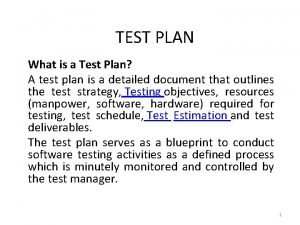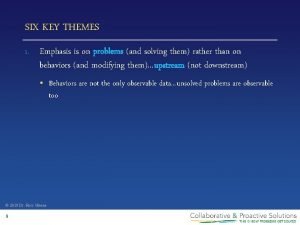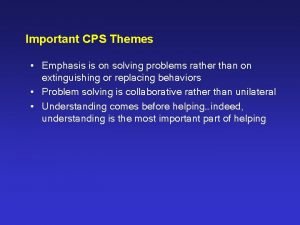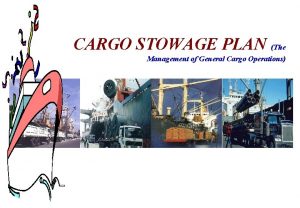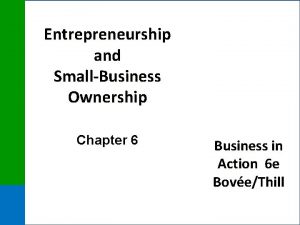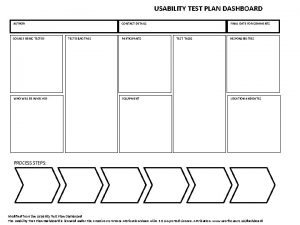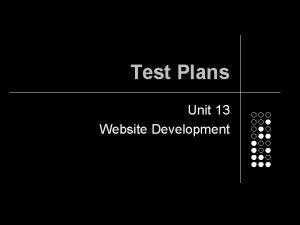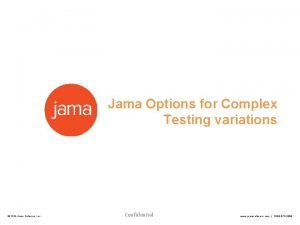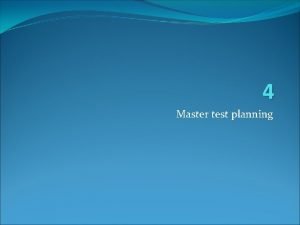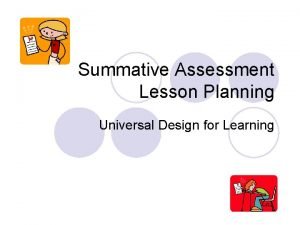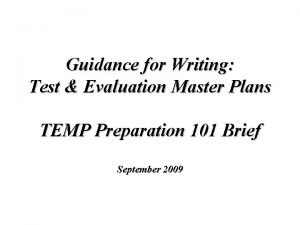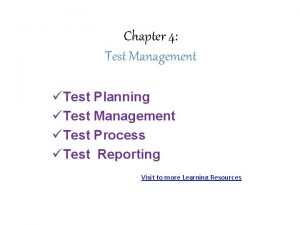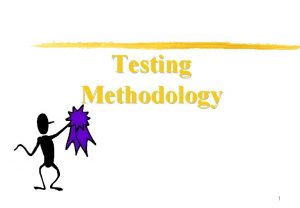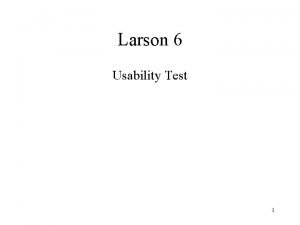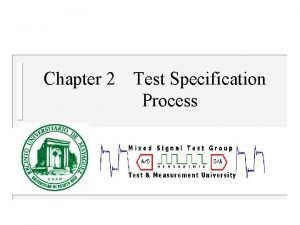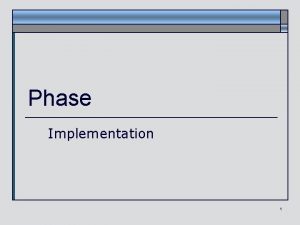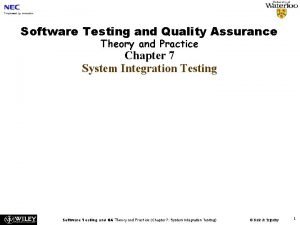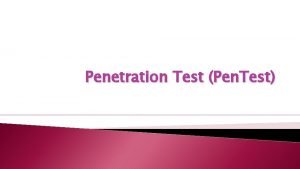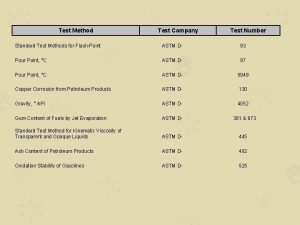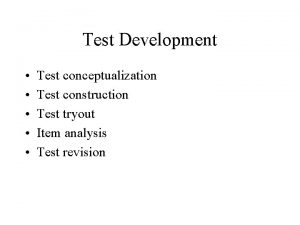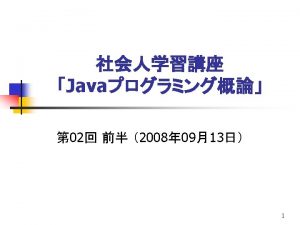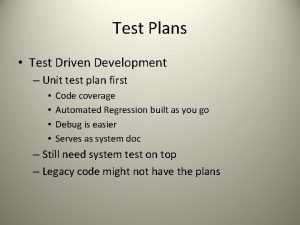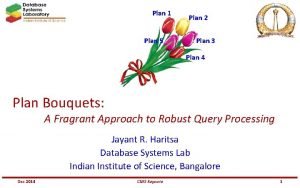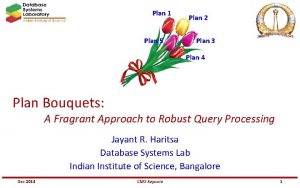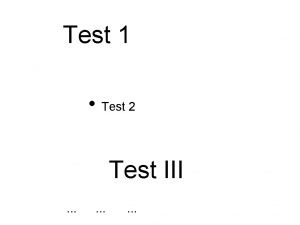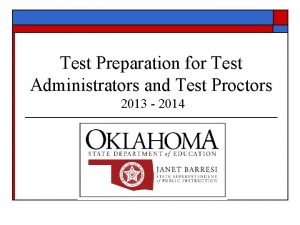TEST PLAN What is a Test Plan A





























- Slides: 29

TEST PLAN What is a Test Plan? A test plan is a detailed document that outlines the test strategy, Testing objectives, resources (manpower, software, hardware) required for testing, test schedule, Test Estimation and test deliverables. The test plan serves as a blueprint to conduct software testing activities as a defined process which is minutely monitored and controlled by the test manager. 1

Importance of Test Plan • Making Test Plan has multiple benefits • Test Plan helps us determine the effort needed to validate the quality of the application under test • Help people outside the test team such as developers, business managers, customers understand the details of testing. • Test Plan guides our thinking. It is like a rule book, which needs to be followed. • Important aspects like test estimation, test scope, Test Strategy are documented in Test Plan, so it can be reviewed by Management Team and re-used for other projects. 2

How to write a Test Plan • Making a Test Plan is the most important task of Test Management Process. Follow the seven steps below to create a test plan as per IEEE 829 • Analyze the product • Design the Test Strategy • Define the Test Objectives • Define Test Criteria • Resource Planning • Plan Test Environment • Schedule & Estimation • Determine Test Deliverables 3

4

1) Analyze the product • How can you test a product without any information about it? The answer is Impossible. You must learn a product thoroughly before testing it. • The product under test is Guru 99 banking website. You should research clients and the end users to know their needs and expectations from the application • Who will use the website? • What is it used for? • How will it work? • What are software/ hardware the product uses? 5

6

2) Develop Test Strategy • Test Strategy is a critical step in making a Test Plan. A Test Strategy document, is a high-level document, which is usually developed by Test Manager. This document defines: • The project’s testing objectives and the means to achieve them • Determines testing effort and costs • Back to your project, you need to develop Test Strategy for testing that banking website. You should follow steps below 7

8

2. 1) Define Scope of Testing • Before the start of any test activity, scope of the testing should be known. You must think hard about it. • The components of the system to be tested (hardware, software, middleware, etc. ) are defined as "in scope" • The components of the system that will not be tested also need to be clearly defined as being "out of scope. " • Defining the scope of your testing project is very important for all stakeholders. A precise scope helps you • Give everyone a confidence & accurate information of the testing you are doing • All project members will have a clear understanding about what is tested and what is not 9

How do you determine scope your project? To determine scope, you must – Precise customer requirement Project Budget Product Specification Skills & talent of your test team Now should clearly define the "in scope" and "out of scope" of the testing. • As the software requirement specs, the project Guru 99 Bank only focus on testing all the functions and external interface of website Guru 99 Bank (in scope testing) • Nonfunctional testing such as stress, performance or logical database currently will not be tested. (out of scope) 10 • • •

Problem Scenario • The customer wants you to test his API. But the project budget does not permit to do so. In such a case what will you do? • Well, in such case you need to convince the customer that API testing is extra work and will consume significant resources. Give him data supporting your facts. Tell him if API testing is included in-scope the budget will increase by XYZ amount. • The customer agrees and accordingly the new scopes, out of scope items are • In-scope items: Functional Testing, API Testing • Out of scope items: Database Testing, hardware & any other external interfaces 11

• Step 2. 2) Identify Testing Type • A Testing Type is a standard test procedure that gives an expected test outcome. • Each testing type is formulated to identify a specific type of product bugs. But, all Testing Types are aimed at achieving one common goal “Early detection of all the defects before releasing the product to the customer” • The commonly used testing types are described as following figure 12

13

• There are tons of Testing Types for testing software product. Your team cannot have enough efforts to handle all kind of testing. As Test Manager, you must set priority of the Testing Types • Which Testing Types should be focused for web application testing? • Which Testing Types should be ignored for saving cost? 14

15

2. 3) Document Risk & Issues • Risk is future’s uncertain event with a probability of occurrence and a potential for loss. When the risk actually happens, it becomes the ‘issue’. 16

17

2. 4) Create Test Logistics In Test Logistics, the Test Manager should answer the following questions: • Who will test? • When will the test occur? • Who will test? 18

You may not know exact names of the tester who will test, but the type of tester can be defined. • To select the right member for specified task, you have to consider if his skill is qualified for the task or not, also estimate the project budget. Selecting wrong member for the task may cause the project to fail or delay. • Person having the following skills is most ideal for performing software testing: • Ability to understand customers point of view • Strong desire for quality • Attention to detail • Good cooperation • In your project, the member who will take in charge for the test execution is the tester. Base on the project budget, you can choose in-source or outsource member as the tester. 19

When will the test occur? • Test activities must be matched with associated development activities. • You will start to test when you have all required items shown in following figure 20

3) Define Test Objective • Test Objective is the overall goal and achievement of the test execution. The objective of the testing is finding as many software defects as possible; ensure that the software under test is bug freebefore release. • To define the test objectives, you should do 2 following steps • List all the software features (functionality, performance, GUI…) which may need to test. • Define the target or the goal of the test based on above features 21

• Let’s apply these steps to find the test objective of your Guru 99 Bank testing project • You can choose the ‘TOP-DOWN’ method to find the website’s features which may need to test. In this method, you break down the application under test to component and subcomponent. 22

23

• Based on above features, you can define the Test Objective of the project Guru 99 as following • Check that whether website Guru 99 functionality(Account, Deposit…) is working as expected without any error or bugs in real business environment • Check that the external interface of the website such as UI is working as expected and & meet the customer need • Verify the usability of the website. Are those functionalities convenient for user or not? 24

4) Define Test Criteria • Test Criteria is a standard or rule on which a test procedure or test judgment can be based. There’re 2 types of test criteria as following • Suspension Criteria • Specify the critical suspension criteria for a test. If the suspension criteria are met during testing, the active test cycle will be suspended until the criteria are resolved. • Example: If your team members report that there are 40% of test cases failed, you should suspend testing until the development team fixes all the failed cases. 25

26

Exit Criteria • It specifies the criteria that denote a successful completion of a test phase. The exit criteria are the targeted results of the test and are necessary before proceeding to the next phase of development. Example: 95% of all critical test cases must pass. • Some methods of defining exit criteria are by specifying a targeted run rate and pass rate. • Run rate is ratio between number test cases executed/total test cases of test specification. For example, the test specification has total 120 TCs, but the tester only executed 100 TCs, So the run rate is 100/120 = 0. 83 (83%) • Pass rate is ratio between numbers test cases passed / test cases executed. For example, in above 100 TCs executed, there’re 80 TCs that passed, so the pass rate is 80/100 = 0. 8 (80%) 27

• This data can be retrieved in Test Metric documents. • Run rate is mandatory to be 100% unless a clear reason is given. • Pass rate is dependent on project scope, but achieving high pass rate is a goal. • Example: Your Team has already done the test executions. They report the test result to you, and they want you to confirm the Exit Criteria. 28

• In above case, the Run rate is mandatory is 100%, but the test team only completed 90% of test cases. It means the Run rate is not satisfied, so do NOT confirm the Exit Criteria • Step 5) Resource Planning 29
 What is test strategy
What is test strategy Alsup ross greene
Alsup ross greene Academic field trip plan a plan b
Academic field trip plan a plan b Short, medium and long term planning in education
Short, medium and long term planning in education Problem solving plan (plan b flowchart)
Problem solving plan (plan b flowchart) Sample of micro teaching lesson plan
Sample of micro teaching lesson plan Problem solving plan (plan b flowchart)
Problem solving plan (plan b flowchart) New jersey plan vs virginia plan
New jersey plan vs virginia plan Cargo stowage
Cargo stowage Layout location
Layout location Man's plan vs god's plan
Man's plan vs god's plan Virginia plan and new jersey plan venn diagram
Virginia plan and new jersey plan venn diagram Va plan nj plan great compromise
Va plan nj plan great compromise People don't plan to fail
People don't plan to fail Building owner chapter 6
Building owner chapter 6 Usability test plan dashboard example
Usability test plan dashboard example Website test plan
Website test plan Jama software labs
Jama software labs Master test plan
Master test plan Lesson plan for summative test
Lesson plan for summative test Ctia test plan for mobile station over the air performance
Ctia test plan for mobile station over the air performance Test and evaluation master plan
Test and evaluation master plan Test summary report template
Test summary report template Stp software test plan
Stp software test plan Usability test plan dashboard
Usability test plan dashboard Test specification plan
Test specification plan Implementation phase meaning
Implementation phase meaning Integration test plan
Integration test plan Cse test plan
Cse test plan Engineers test idea for new
Engineers test idea for new
